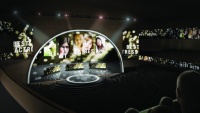Prysm unveils laser based display
Laser display technology is said to produce superior imagery and a wide viewing angle. Dave Wilson reports

The cathode-ray tube established itself in the last century as the de-facto standard by which images were displayed and, up until the last decade, most television sets and computer monitors were built around one.
But, over the past 10 years, display technology has evolved frenetically and the limitations of the cathode-ray tube with its bulky, heavy and fragile evacuated glass tube have been overcome by a new range of liquid-crystal and plasma displays without the same disadvantages.
Nevertheless, these newer display technologies have brought with them their own set of issues – they are complex to manufacture, consume considerable power and can suffer from problems such as narrow viewing angles, poor colour rendition, burnt-out picture elements and picture burn-in.
Now there’s a new kid on the display block that promises to overcome all of these issues. Developed by a team of engineers working in ’stealth mode’ for the past five years at San Jose-based Prysm, the Laser Phosphor Display (LPD) combines old-style CRT elements with laser technology.
Register now to continue reading
Thanks for visiting The Engineer. You’ve now reached your monthly limit of premium content. Register for free to unlock unlimited access to all of our premium content, as well as the latest technology news, industry opinion and special reports.
Benefits of registering
-
In-depth insights and coverage of key emerging trends
-
Unrestricted access to special reports throughout the year
-
Daily technology news delivered straight to your inbox










Water Sector Talent Exodus Could Cripple The Sector
Maybe if things are essential for the running of a country and we want to pay a fair price we should be running these utilities on a not for profit...